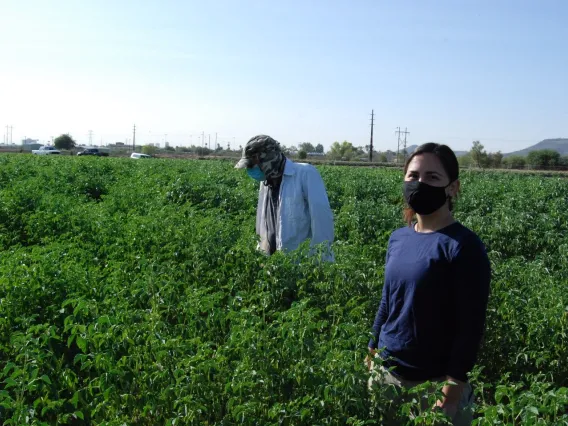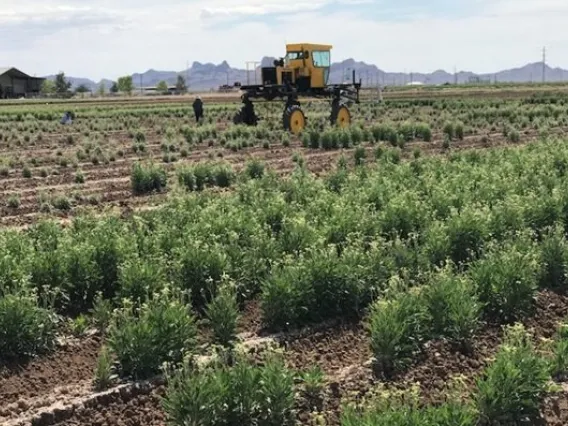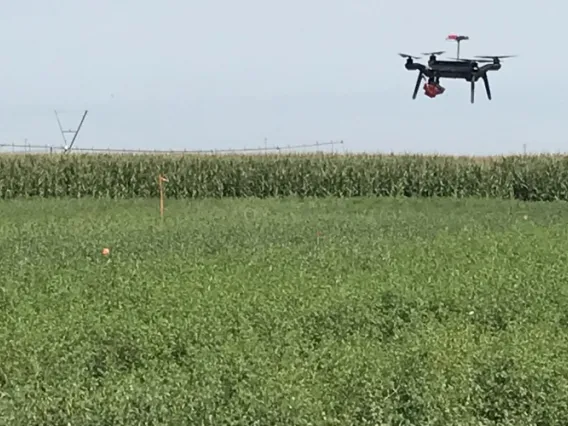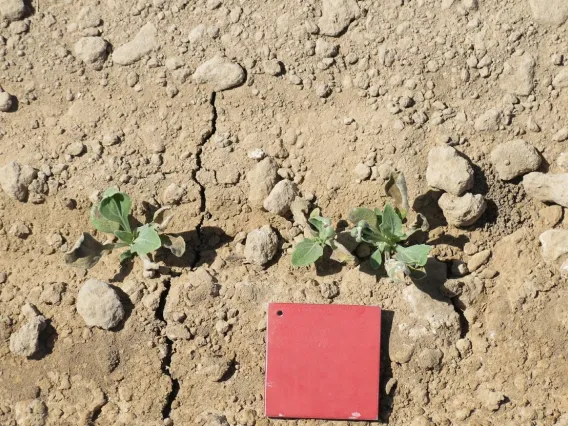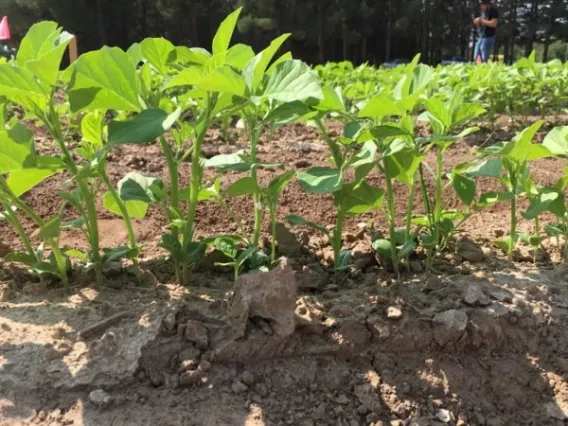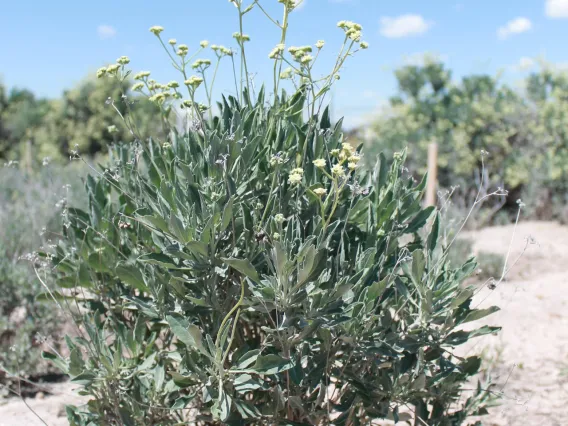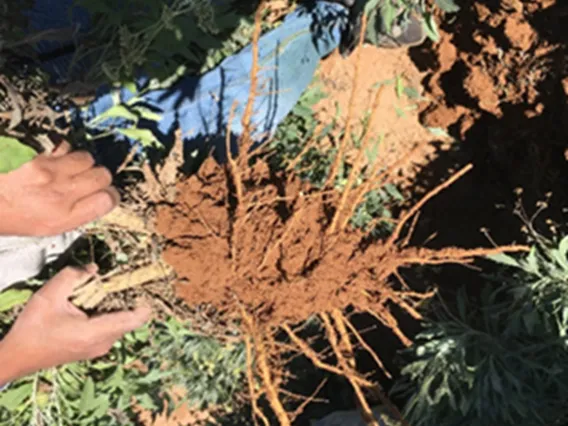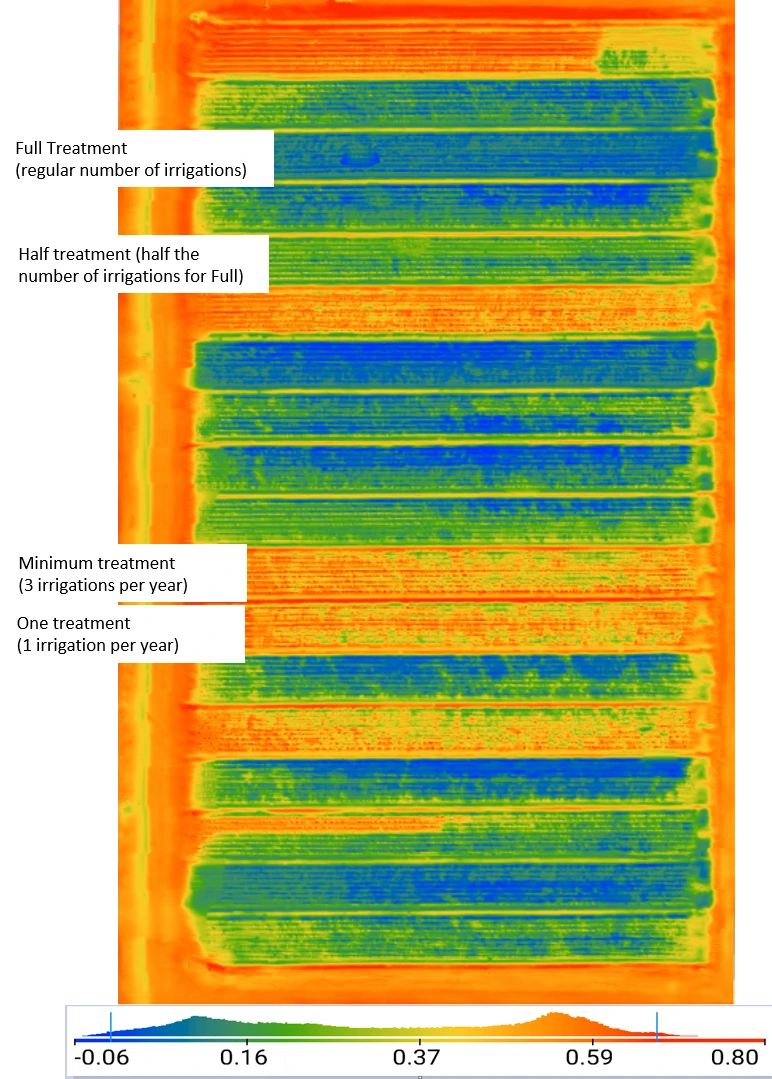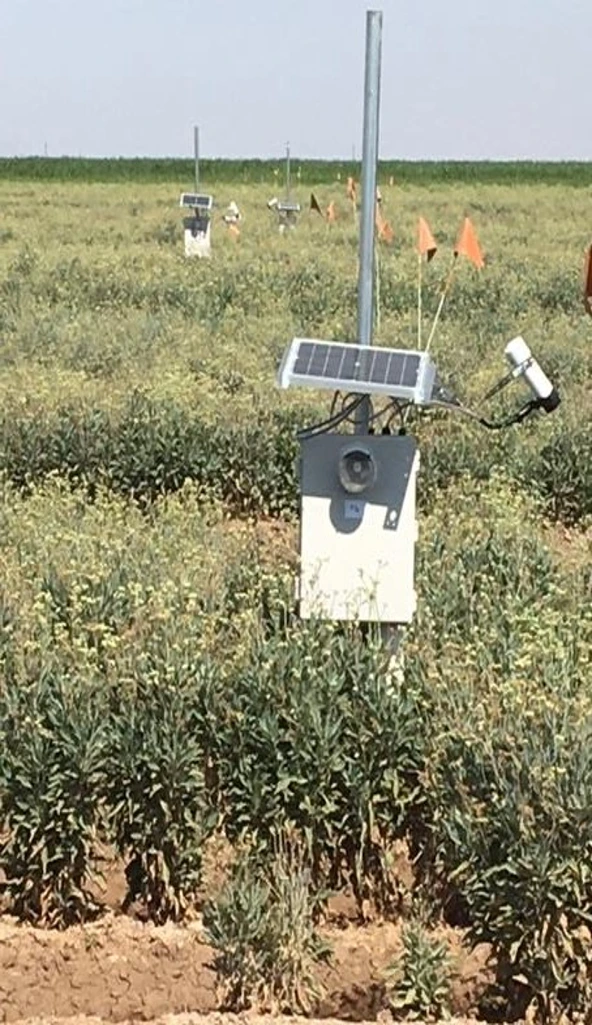Navigation
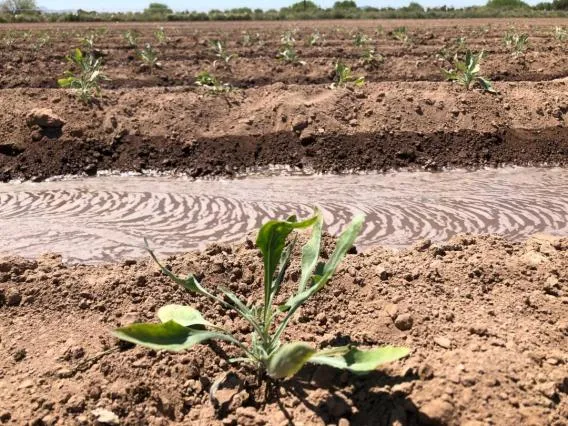
Guayule Deficit Irrigation Study
under development
Guayule Regional Yield Test
A two-year yield test was completed in 2020 for guayule. Initially established in April 2018 at Maricopa Agriculture Center (46 lines) in Maricopa, Arizona and at the Bridgestone Research Farm (55 lines) in Eloy, Arizona. Both locations were harvested in April 2020.
Initial results:
- Mean Dry Weight: 26,802 kg/ha (Eloy); 19,287 kg/ha (Maricopa)
- Mean Resin Content: 4.7% (Eloy); 4,8% (Maricopa)
- Mean Resin Yield: 1430 kg/ha (Eloy); 968 kg/ha (Maricopa)
- Mean Rubber Content: 2.5% (Eloy); 2.5% (Maricopa)
- Mean Rubber Yield: 716 kg/ha (Eloy); 503 kg/ha (Maricopa)
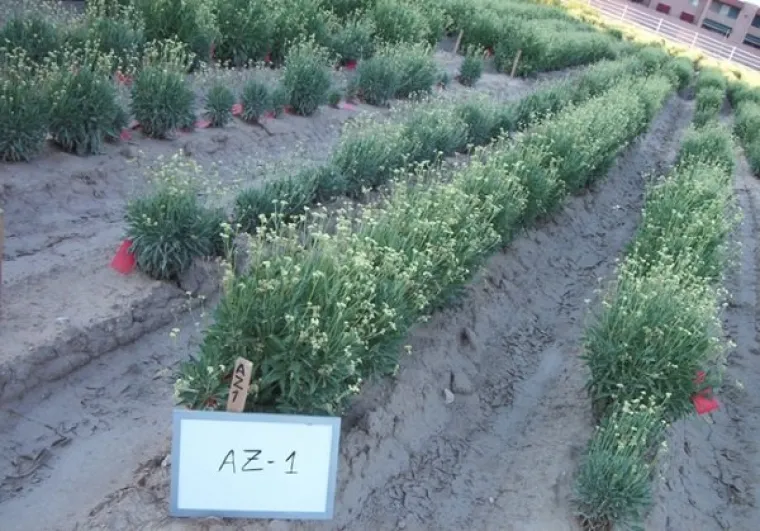
Germplasm line planted in Arizona.
There were genotype X environment interactions between locations. The top five rubber yielding lines were different between the two locations, with only one line (CAL7), in the top five lines at both. There was also significant diversity for each measured character. For instance, at Eloy, rubber yield ranged from 1,639-154 kg/ha, and 931-167 kg/ha at Maricopa. One line (AZ-2) showed consistent results at both locations: resin content of 7.2% and 7.9%, rubber content of 3.1% and 3.4%, dry matter production of 24,992 kg/ha and 29,935 kg/ha, resin yield of 1,805 kg/ha and 1,851 kg/ha, and rubber yield of 759 kg/ha and 801 kg/ha, at Eloy and Maricopa, respectively.
Mean rubber and resin content were essentially the same at both Eloy and Maricopa. Mean dry weight was much greater at Eloy than at Maricopa. Differences in locations were due mainly to soil type and water holding capacity, having a heavier clay soil at Eloy and a sandier soil at Maricopa. Dry weight has the highest correlation with rubber yield, thus, mean rubber yield was highest at Eloy.
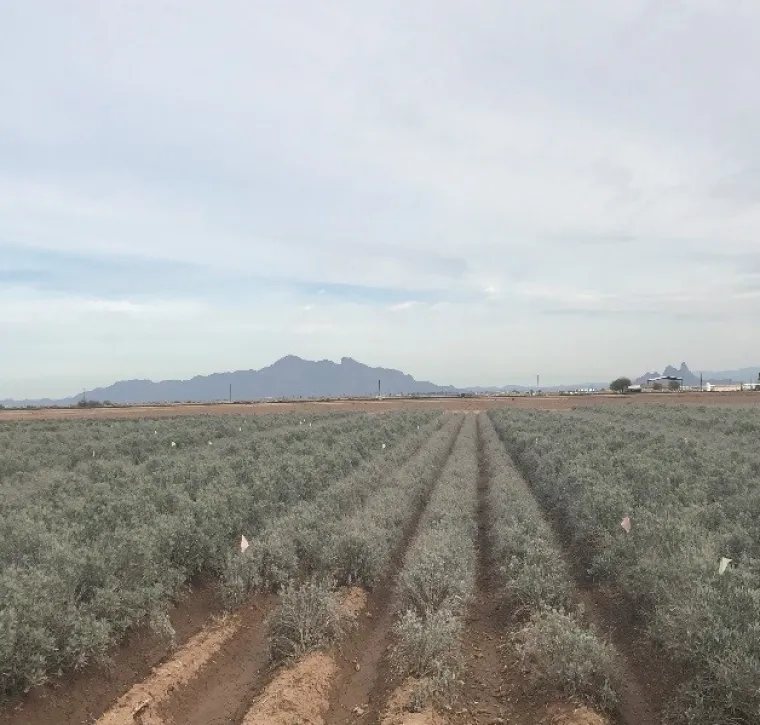
Guayule growing in the field, Eloy, Arizona.
Assuming an economic yield of 27,850 kg/ha dry weight: 29 of 55 (Eloy), 9 of 46 (Maricopa) lines yielded above this level at each location. Plant breeding is dependent upon having genetic diversity from which to make selections There was significant diversity fall traits evaluated.
AZ-2 is the default line for production at this time. Although, the rankings were different at the two locations, AZ-2 always was within the highest group statistically, and yielded closely at both locations. This shows stability over different environments, making it a good choice for initial commercialization.
Fact Sheets
|
Image
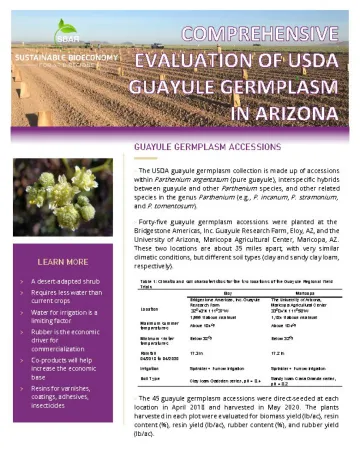
Comprehensive Evaluation of USDA Guayule Germplasm in AZ Fact Sheet.pdf |
|---|
Research Leads
Guar Regional Yield Tests
A two-year yield test for guar was completed in 2020 in Arizona and New Mexico. Guar was initially established in June 2019 in Tucson, Arizona (30 lines), and in Las Cruces (28 lines) and Clovis (29 lines), New Mexico. The plants were harvested in October and November 2019.
Initial results:
- Mean seed yield: 2807 kg/ha (Tucson); 1962 kg/ha (Las Cruces); 845 kg/ha (Clovis)
- Range in seed yield: 3,177-1,915 kg/ha (Tucson); 2,667-1,120 kg/ha (Las Cruces); 1,129-73 kg/ha (Clovis)
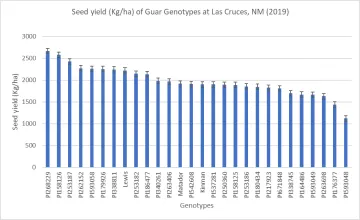
Guar genotype seed yield at Fabian Garcia Plant Science Center, Las Cruces, NM (2019)
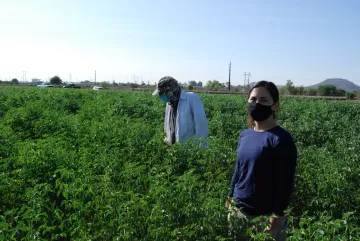
Guar variety trial in Tucson, Arizona (60 days after planting).
Plant breeding is dependent upon having genetic diversity from which to make selections. There was significant diversity for all traits evaluated. Assuming an economic seed yield of 1,009 kg/ha, there were yields above this level at all three locations. Yields were significantly higher at Tucson and Las Cruces. The lower yields at Clovis were due to excessive rain at the wrong time during plant development. Both amount and timing of applied water are important for guar growth and production.
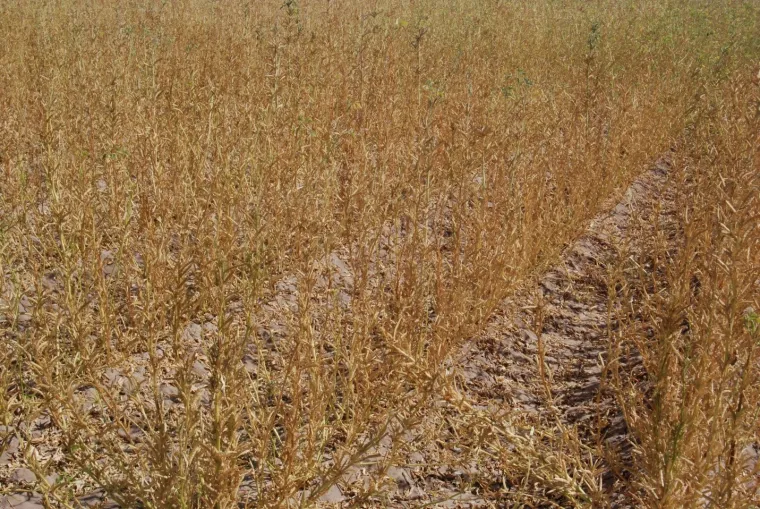
Guar variety trial in Tucson, October 2020 (120 days after planting), just before harvest.
Research Leads
Phenotyping Guayule and Guar
Guayule Accessions
A plant’s phenotype, its observed physical and biochemical characteristics, is a result of both its genetic makeup and environmental influences. Phenotyping germplasm is essential in plant breeding programs, but information available for guayule and guar in the USDA National Plant Germplasm System is minimal and sometimes conflicting. Thus, we are phenotyping each guayule and guar germplasm line at multiple locations, allowing for the estimation of environmental effects on different traits.

Tractor equipped with high throughput sensors.
A tractor equipped with high throughput sensors to measure biomass, canopy temperature, plant height, and plant architecture is used to phenotype guayule. Other measurements include rubber/resin quantity and quality, leaf classification and leaf area index, flowering time and amount, and germination ploidy.
Significant results:
- Phenotypic variations in 2-year plant heights were observed among guayule accessions. Plant heights range from 117 cm (CAL7) to 50 cm (CAL3). “Improved” guayule accessions were taller than other accessions.
- Normalized Difference Vegetation Index (NDVI) and Normalized Difference Red Edge (NDRE) that are indicators of plant health, canopy temperature (CT) that explains the stresses on plants were estimated for one-year old guayule plants.
- There is significant variation among guayule accessions in NDVI, NDRE, and CT.
- Plant height is positively correlated with rubber content, resin content, fresh biomass, dry biomass, and rubber and resin yield.
- There are positive significant correlations among DNVI and NDRE, as well as resin and rubber contents.
- Plant height was positively correlated with NDVI and NDRE, and negatively correlated with CT.
USDA guayule accessions have a wide phenotypic range for the studied traits. This is the basis for selecting parental genotypes in the next breeding cycle. Correlations among rubber and resin content and remote sensing traits could allow for quicker and earlier prediction of rubber and resin content.
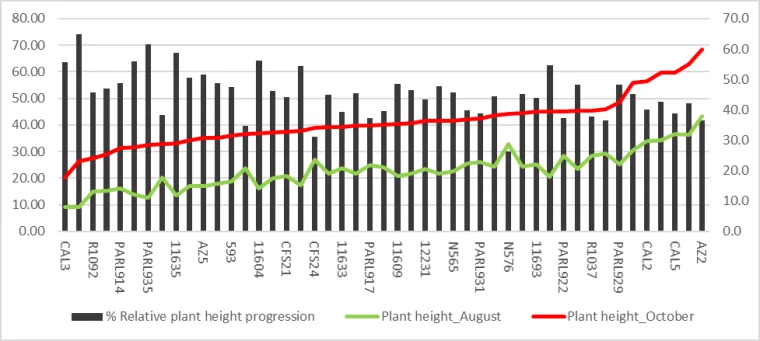
Phenotypic variations in plant height, within the USDA guayule accessions.
Phenotypic Stability under Drought Stress Conditions
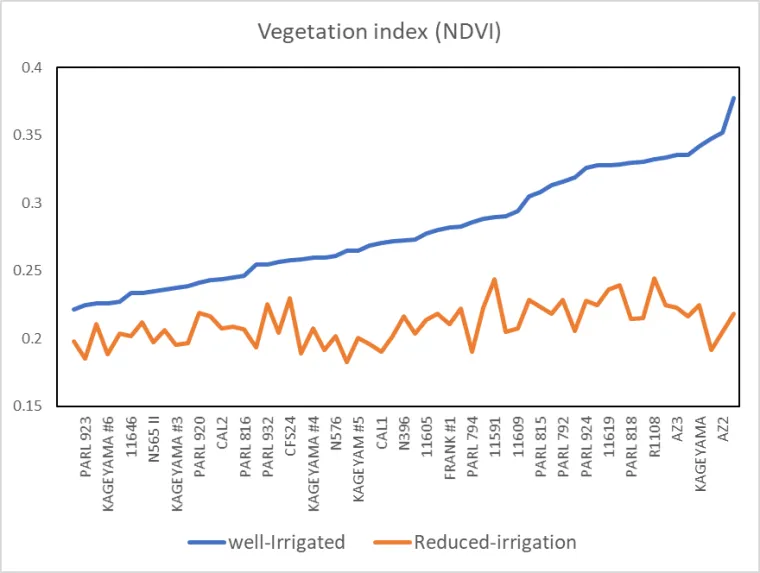
Normalized Difference Vegetation Index (NDVI) for guayule accessions under well-irrigated (blue line) and reduced irrigation (red line) at the Maricopa Agricultural Center, Arizona.
Guayule genotypes were planted under water stress and non-water stress conditions at Maricopa, Arizona. One-year old guayule plants are higher in fresh weight and height under the well-watered condition, compared to the reduce-water condition. Phenotypic diversity is observed among guayule genotypes planted under the water stress conditions. There are wide phenotypic variations in NDVI and CT between environments and among genotypes.
There appears to be drought tolerance among the USDA guayule collection. This is the basis for parental selection to improve guayule drought tolerance for semi-arid and marginal land agricultural systems. Some guayule genotypes are more stable under stress conditions, indicating that it is possible to breed for drought tolerance. For example, PARL 923 is more stable than AZ-3 for NDVI values.
Guar Phenotyping
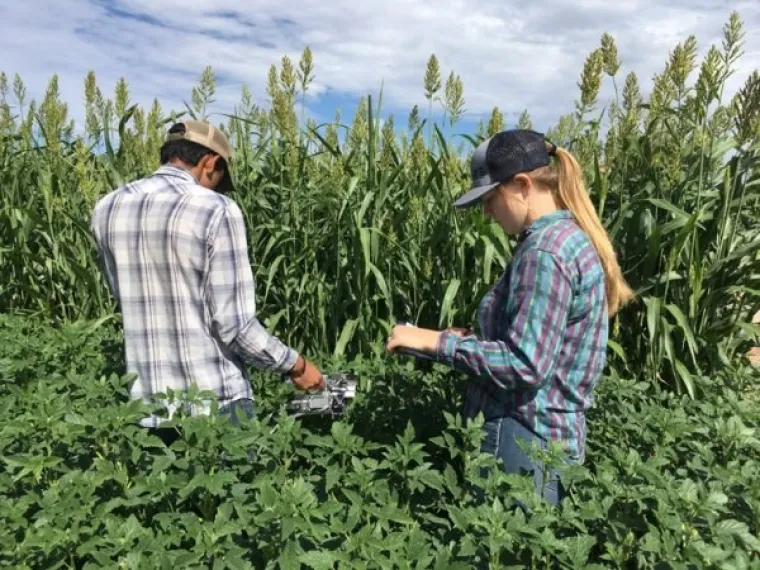
Taking photosynthesis measurements in guar field, New Mexico
In guar, directly measured phenotype parameters include plant height, plant architecture, stem morphology, leaf size and shape, flowering time, raceme length, pod/seed size and number, and biomass yield under different water management and planting schemes. These data will not only be invaluable in breeding programs, but will help in deciding traits/lines best suited for different environments and cultural practices in the southwestern United States.
Guar Genetic Variation for Germination and Early Growth in Cooler Soils
Guar is primarily produced in worldwide locations of lower altitude with warm growing seasons. To be sustainably produced in the Southwest, genetic characteristics that demonstrate cold tolerance will help in breeding cultivars that will enable expansion of guar production to cooler regions. Current guar cultivars available for production vary in their germination and seedling growth at low temperatures. Although some cultivars germinate well at lower temperatures, their seed vigor generally requires warmer temperatures for quicker guar establishment. Through SBAR-research, it has been documented that the cultivar “Kinman” is ideal for planting in cooler soil conditions.
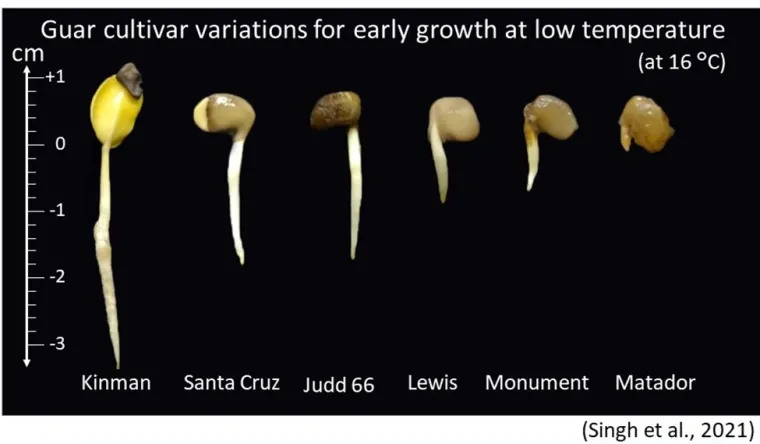
Guar cultivar variations for early growth at low temperature (16°C).
Study Results
Salinity Tolerance in Guar Genotypes
Four diverse guar lines were studied for their salinity tolerance (Electrical Conductivity (E.C. = 16 dS m-1) in a greenhouse lysimeter at the United States Salinity Laboratory. Matador and PI268229 maintained shoot and root biomass under salinity stress, whereas accessions PI340261 and PI537281 showed a significant decrease in shoot and root biomass under salinity stress.
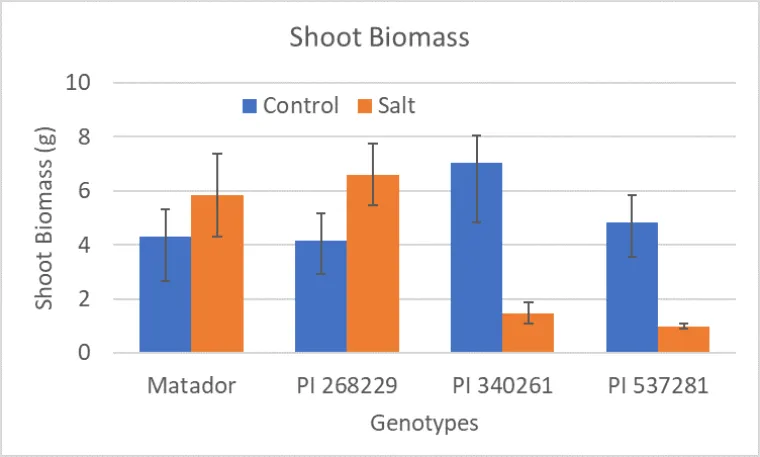
Comparison of shoot biomass of different guar genotypes under control and high salinity conditions.
PI268229 and Matador were identified as salt tolerant, based on the consistent expression of four traits: shoot biomass, root biomass, shoot height, and root length. In the Guar Regional Variety Trial, PI268229 ranked the highest in seed yield (2,667 Kg/ha) and biomass production (7,367 Kg/ha) at Las Cruces, New Mexico in 2019.
Research Leads
Irrigation: Quantity and Time of Application
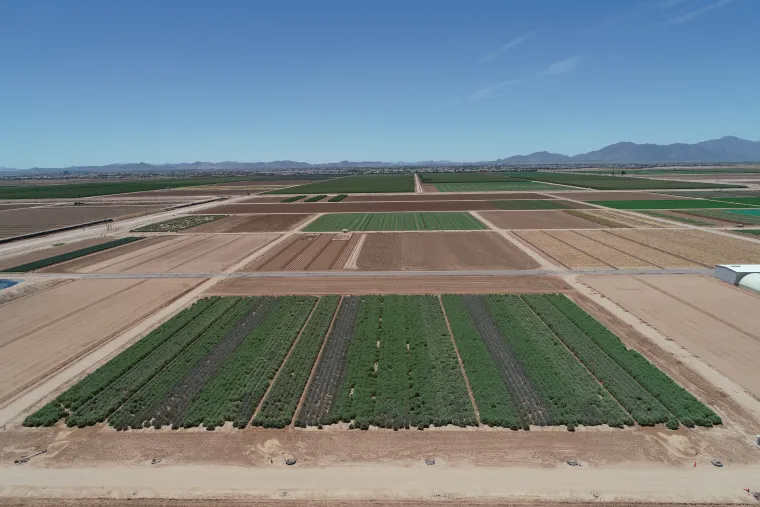
Guayule irrigation treatments at Maricopa Agricultural Center, Arizona
Irrigation for Guayule Production
Irrigation water supply is critically important in desert agriculture. To better understand the intersection of economic guayule production and irrigation water requirements, SBAR researchers have begun several irrigation experiments. Guayule field irrigation experiments at Maricopa and Eloy research farms yielded the following significant results on the water demand and water implications of this desert shrub.
- Rubber and resin contents (%) decreased with increasing water application rate, but rubber yield increases in sandy soil and decreases in clay soil.
- Irrigation rate should not exceed 100% of estimated evapotranspiration for sandy loam and 75% of evapotranspiration in clay soils.
- The sandy loam soil had much higher rubber yields than the clay soil for both irrigation systems at 100% application rate, but similar yields at 75% application rate.
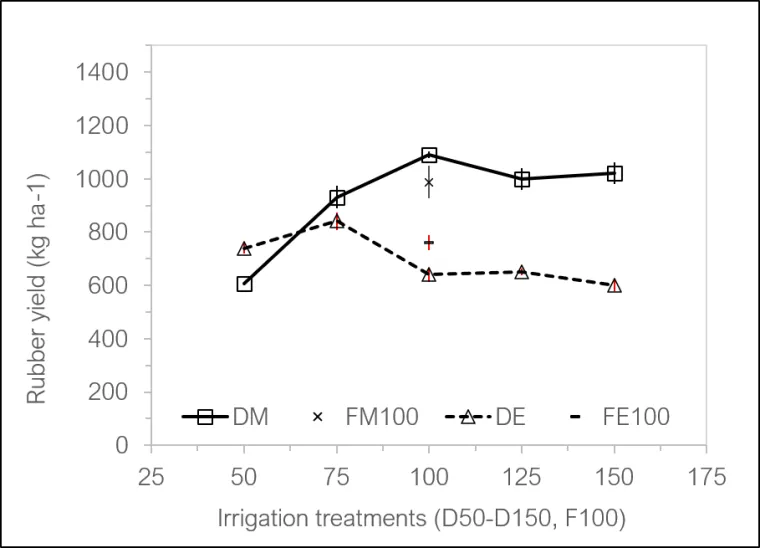
Rubber yield under varying irrigation treatments (DM=drip Maricopa; DE=drip Eloy; FM=flood Maricopa; FE=flood Eloy).
With this information, growers will be ready to make decisions about irrigation, salinity, and nutrient management.

A DJI Phantom Pro V2 drone used to collect regular (Red-Green-Blue) images that can show irrigation deficits in crops.
SBAR researchers have also developed the guayule crop coefficient (Kc) curve using the first two years of growth. Unlike other crops, a Kc curve was not available for guayule, and the development of a remote sensing Kc curve model provides a tool for transferring derived data from this study to other evapotranspiration estimates for guayule production fields across the Southwest.
A water deficit index (WDI) was developed using thermal images taken in October 2020 of guayule fields in Eloy, Arizona. Values range from 0-1, with 1 for stressed conditions and 0 for non-stressed conditions. The lowest irrigation treatments had higher WDI values, which indicates lower moisture content. The other treatments were irrigated a few days before the drone flight, so they appear as green-blue in the images, which indicates higher moisture content.
Guayule is an ideal crop for sensor irrigation management because it can be water stressed and have an increase in canopy temperature without necessarily losing yield. A team of SBAR researchers developed a remotely accessible sensor system to measure soil moisture and evaluate crop stress over time.
An irrigation computer model, WINDS (Water-use, Irrigation, Nitrogen, Drainage, and Salinity), was modified to evaluate data from the Eloy and Maricopa experiments. Information gained will be used to determine an appropriate irrigation schedule for guayule as it goes to full production.
Irrigation for Guar Production
A guar irrigation study has been completed over three years (2018, 2019 and 2020), where plants were established between June and July and harvested each year in November. Preseason irrigation ranged from 119 mm (2019) to 127 mm (2019) and was applied with bubbler pads (for deep soaking) in 3-4 irrigations. In-season irrigation ranged from 23 mm (rainfed) to 199 mm (full season irrigation) in 2018 and 46 mm (rainfed) to 270 mm (full season irrigation in 2019, respectively.
Not irrigating after flower initiation saved 64% and 55% in 2018 and 2019 irrigation water without losing significant guar yield. The 2019 growing year was unusual and extremely stressful for most crops with very low guar seed yield. The 2020 growing year was warmer and rainfall was half of the long-term average. Seed yields were also much lower. Interactions between irrigation strategies and cultivars was not significantly different for most parameters.
With deficit irrigation strategies, guar an be grown with less water without significantly reducing seed yield. With declining irrigation water resources, a crop like guar, which is stress tolerant and requires less water, input and management will be extremely useful for the southwest.
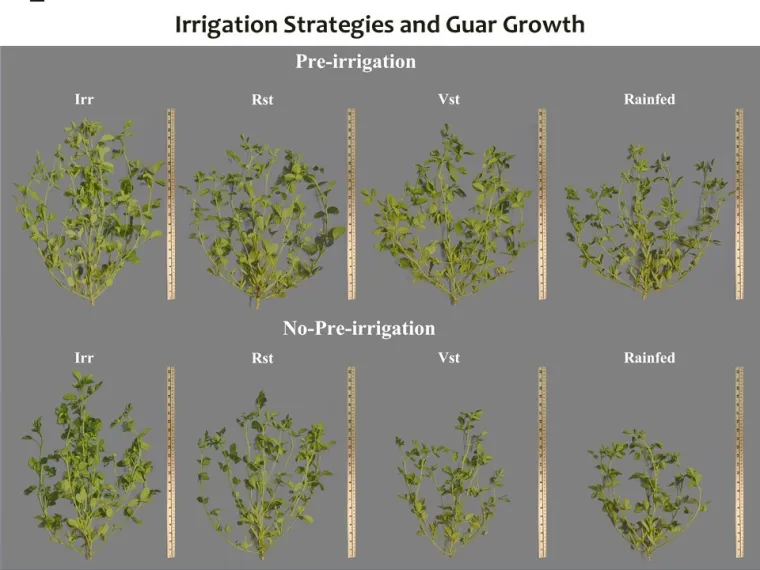
Plant structural growth images taken in November 2020 from guar fields in Clovis, New Mexico.
Research Leads
Developing an Herbicide Regimen for Guayule
Guayule is a desert adapted perennial shrub with slow seed germination and seedling growth that are not competitive with Arizona’s fast growing annual weeds. However, once canopy closure occurs in the seed-row, guayule is competitive against weed seedlings. Additionally, guayule leaves have thick cuticles with leaf hairs that may provide tolerance to some postemergence herbicides.
Guayule herbicide tolerance studies have identified several preemergence and postemergence herbicides that can be safely used to provide weed control during establishment and early crop growth.
Postemergence Herbicides
- Guayule is resistant to the selective grass herbicides fluazifop-p-butyl (e.g., Fusilade DX), sethoxydim (e.g., Poast), and clethodim (e.g., Select). These herbicides can be sprayed topically at any guayule growth stage to control annual and perennial grasses.
- Four true-leaf and larger guayule seedlings are tolerant of the contact burn-down PPO (protoporphyrinogen oxidase) inhibiting herbicides such as carfentrazone (e.g., Aim). There is some leaf injury but the plants are able to grow out of the injury in good growing conditions.
- Research is being conducted to identify additional preemergence and postemergence herbicides for broadleaf weed control.
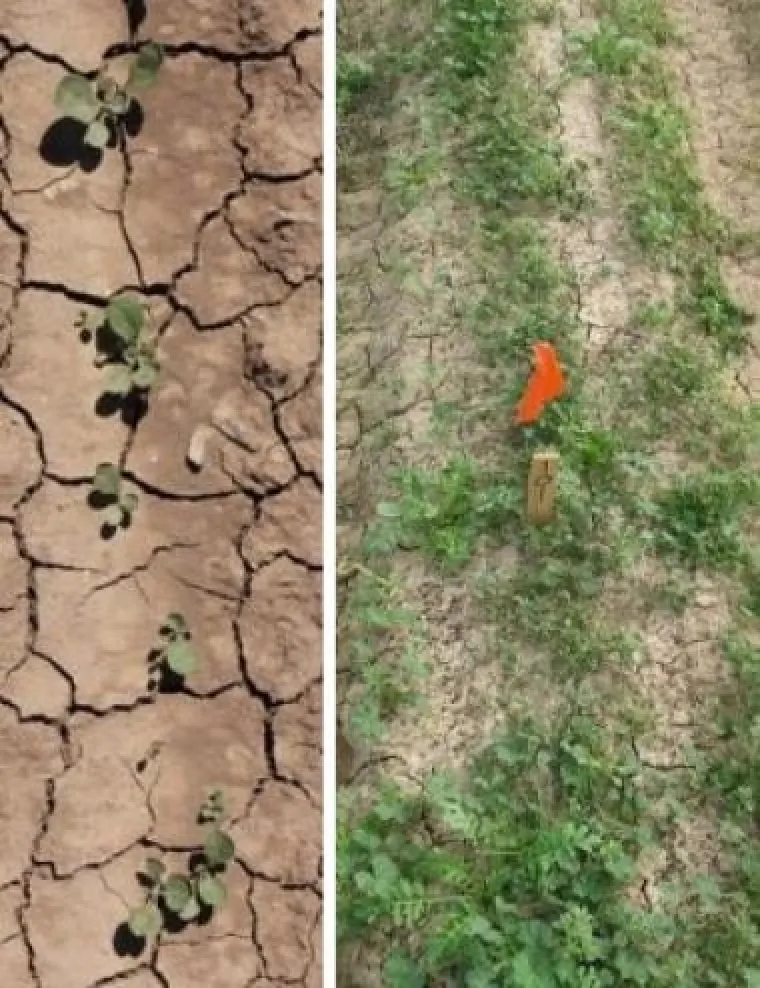
Preemergence Herbicides
- Metolachlor (Dual Magnum) and sulfentrazone (Spartan) are safe up to 2X normal rates in both sandy loam and clay loam soils. They can be sprayed topically after planting and incorporated with sprinklers or can be shallowly incorporated on the bed-top prior to planting.
- Acetochlor (Warrant) and bensulide (Prefar) are safe up to 2X normal rates when shallowly incorporated on the bed-top. If they are applied preemergence after planting and incorporated with sprinkler irrigation there is some stand loss but good crop populations can still be obtained at 2X and lower rates.
- Ethalfluralin (Sonalan) and pendimethalin (Prowl H2O) are safe at 2X normal rates and lower when mechanically incorporated into the soil. Preemergence use (i.e., sprayed after planting and incorporated with sprinkler irrigation) causes loss of plants in sandy loam soils but there is much less loss in clay loam soils. Thus, rates need to be adjusted according to soil type especially when the herbicides are applied preemergence. Guayule seedlings may grow slower initially in sub-optimal growing conditions such as in cold soils.
Current research is focused on developing weed control programs combining these herbicides and cultivation during stand establishment followed by early season carfentrazone and fluazifop-p-butyl to control escaped broadleaf and grass weeds, respectively. As the plants get larger and the canopy in the seed-row begins to close, cultivation, and post-directed, pre- and post-emergence herbicide sprays with a hooded sprayer can be used to maintain weed control.
|
Image

Guayule Weed Mgmt During Establishment in AZ.pdf |
|---|
Research Leads
Other Agronomic Studies for Guayule and Guar
Expanding the Growing Range
Expanding the cultivation range of guayule and guar is important, and addressed by understanding and testing for cold tolerance among the available germplasm lines. In guayule, we will use metabolomics to understand cold stress and acclimation, using time course data collected and plants screened at -8°C and -9°C, with hundreds of metabolites analyzed from acclimated and non-acclimated plants, and from plants that are freeze tolerant. Soil temperature for germination is the major limiting factor in expanding the growing range of guar. We will germinate (in an incubator) six elite guar cultivars at germination temperatures from 10°C-24°C (50°F-75°F). The results will then be used in test plantings at latitudes north of the present growing range.

Guar seedlings in a planting density study, Las Cruces, New Mexico.
Optimum Plant Densities
New varieties and establishment systems require a reassessment of cultural practices such as planting density in both guayule and guar. In guayule, two lines are direct seeded at two locations and thinned to 3, 6, 12, 18, and 30in. spacing between plants. Guar lines with different plant architecture (branching, basal branching, non-branching) demand new tests looking at different plant densities and distance between rows.
Research Leads
Downregulating Flowering to Improve Yield in Guayule
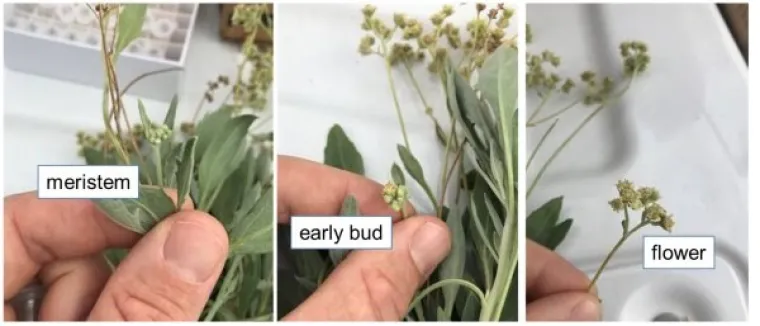
New studies: flowering-related genes' expression in field plants. Tissues sampled for 2 year old and ca. 6 month old plants; gene expression studies pending.
A novel approach to improve biomass quantity and quality, and potentially rubber and resin quantity and quality, is to reduce or eliminate flowering in guayule. Guayule flowers indeterminately (when water is not limiting), and flowers can account for up to 10% of the total biomass at harvest. However, flowering structures contain less than 1% of the total rubber in the plant. Thus, we hypothesize that by reducing flowering, the photosynthate used to produce flowers would be available to add biomass and possibly rubber at harvest. The objective of this aspect of the project is to reduce or eliminate flowering in guayule by controlling the expression of flowering-related genes.
Research Leads
Soil Health Impacts of the Microbiome on Sustainable Feedstock Production
The soil microbiome community affects plant growth and health, and plants have a corresponding effect on the soil microbiome community. Dryland ecosystems, such as the desert southwestern United States, occupy nearly half of the Earth’s surface. A recent survey confirmed that increasing aridity reduces the diversity of soil bacteria and fungi in dryland soils. Optimization of production will depend on understanding the desert soil microbial communities essential to supporting plant health and nutrient cycling, and how they change under different cultural practices.
Guayule rubber production is highest during winter dormancy. SBAR researchers have characterized the guayule root-zone microbiome as a function of the plant metabolic state to identify potential associations between plant rubber content (%) and the soil microbiome. Soil microbial community biomass was significantly higher during winter dormancy than prior to dormancy. The root-zone bacterial/archaeal community composition was significantly different during winter dormancy than prior to the onset of increased rubber production. Guayule rubber content (%) was positively correlated with the quantity of soil microbial community biomass, but negatively correlated with soil organic matter, shrub mass and the plant health index (NDVI). The relative abundance of 10 root-zone bacterial families and 3 fungal classes correlated positively with guayule rubber content (%).
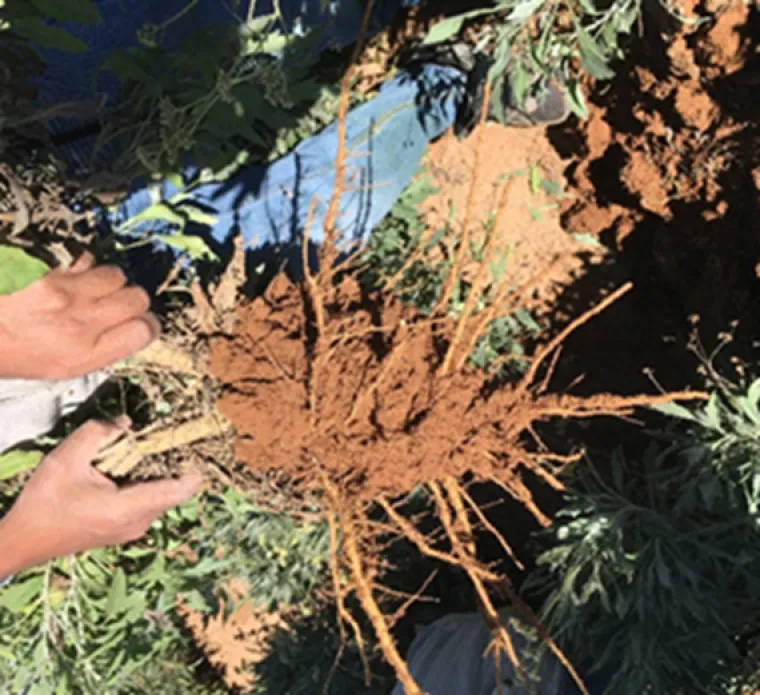
Guayule plant root zone soil used to characterize the root-zone microbiome.
Signaling between soil microbes and plant roots has been shown to produce plant responses (i.e., specific bacteria produce plant growth hormones known to impact plant root structure). The strong correlation between guayule rubber content and the abundance of the total microbial root-zone community as well as the relative abundance of specific bacterial and fungal taxa suggests that microbial community dynamics may influence rubber production.
Rubber production in guayule is hypothesized to be a plant stress response. Microbial impacts on plant stress responses have been previously documented for other plant species, thus the soil microbial community dynamics could possibly be manipulated to enhance guayule rubber production.
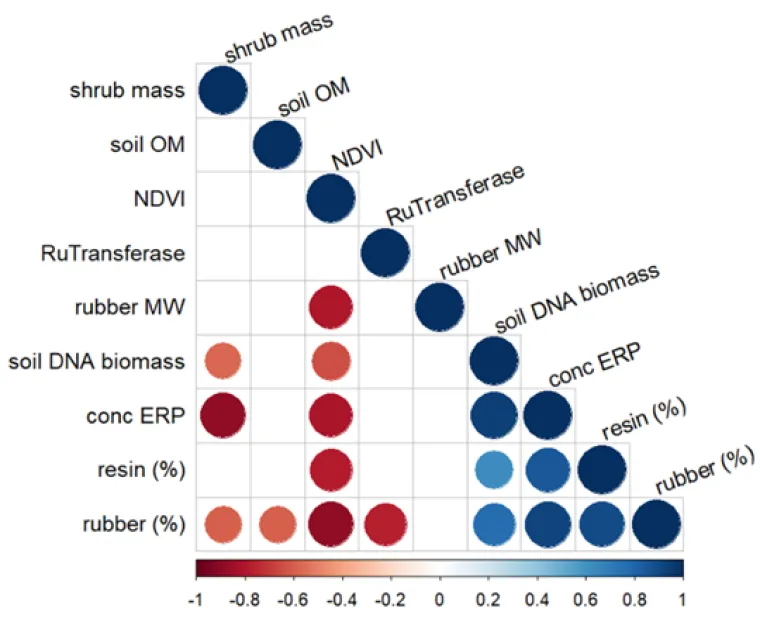
Soil and plant factors that associate with guayule rubber content. [NDVI: Normalized difference vegetation index; RuTransferase: rubber transferase enzyme activity; conc ERP: concentration extractable rubber particles]
In the figure of soil and plant factors associated with guayule rubber content, a blue circle represents a positive association (i.e., % rubber and soil DNA biomass) and a red circle represents a negative association (i.e., % rubber and soil organic matter). The larger and darker colored circles represent stronger associations.



